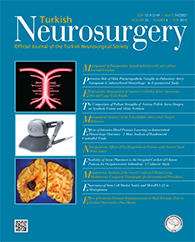2Bakirkoy Sadi Konuk Research and Education Hospital, Department of Radiology, Istanbul, Turkey
3Istanbul University, Cerrahpasa School of Medicine, Department of Radiology, Istanbul, Turkey
4GATA Haydarpasa Teaching Hospital, Department of Radiology, Istanbul, Turkey DOI : 10.5137/1019-5149.JTN.8611-13.0 Aim: Superior cerebellar artery (SCA) aneurysms are uncommon vascular lesions, thus data about their presentation and clinical management are limited. Our aim was to determine clinical presentation, angiographic findings and mid and long-term clinical and imaging results of endovascular treatment of 49 patients with SCA aneurysm.
MaterIal and Methods: Forty-nine patients with SCA aneurysms underwent endovascular treatment (25 female, 24 male; mean age 46.7 years; range, 21-79 years) in our institution. Both aneurysms arising at the origin of SCA and peripheral SCA aneurysms were included to our retrospective study. 73.5% of the patients were presented with subarachnoid hemorrhage. Forty-two of 49 (85.7%) aneurysms were located in the origin of SCA. Mean aneurysm size was 6.5 mm (range 2-16 mm).
Results: Forty-seven (95.9%) of the aneurysms were coiled with detachable coils. In two peripheral aneurysms, liquid embolic agent was used. Overall control angiographic occlusion rates were as follows: 87.5% (34/40) total occlusion and 12.5% (6/40) dog-ear remnant. All peripheral SCA aneurysms were occluded with the parent artery. Procedure related mortality was seen in one patient (2%) due to the rupture of another aneurysm. There was no procedure related permanent morbidity.
Conclusion: Endovascular treatment is an effective and safe option in both peripheral and proximal SCA aneurysms.
Keywords : Superior cerebellar artery, Aneurysm, Endovascular, Subarachnoid hemorrhage




